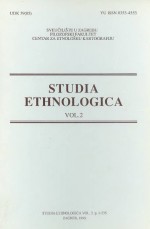At the Interface of the Germanic, Romance and Slavic Worlds: Folk Culture as an Idiom of Collective Self-Images in Southeastern Alps
At the Interface of the Germanic, Romance and Slavic Worlds: Folk Culture as an Idiom of Collective Self-Images in Southeastern Alps
Author(s): Robert Gary MinnichSubject(s): Customs / Folklore, Geography, Regional studies, Cultural Anthropology / Ethnology, Identity of Collectives
Published by: Sveučilište u Zagrebu, Filozofski fakultet
Keywords: Southeastern Alps; folk culture; collective images; cultural identity; ethnicity;
Summary/Abstract: The interface alluded to in the title of this paper is the historic zone of language contact designated by the intersection of the contemporary state frontiers of Austria, Italy and Yugoslavia. This paper is based upon prolonged field research in marginal agrarian communities, located on either slope of the Carnian Alps in Austria and Italy, where Slovene vernacular has been spoken by the majority of residents since approximately 600 A. D. The national models for collective self-identification introduced into this region over the past century - that is, the inclusive social categories represented by the terms German, Italian and Slovene - are for the most part rejected by this indigenous Slovene speaking population. This draws our attention to collective self-identification as a manifestation of social process in local society and introduces the question addressed by this paper: In what ways is it possible to conceive of 'folk culture' as an idiom of collective self-images, that is, as a manifestation of social discourse as it unfolds in local society?
Journal: Studia ethnologica Croatica
- Issue Year: 1990
- Issue No: 2
- Page Range: 163-180
- Page Count: 18
- Language: Croatian

